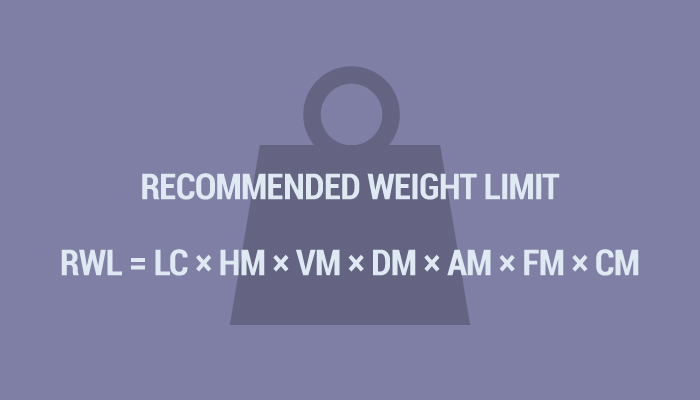We use cookies to make your experience better. To comply with the new e-Privacy directive, we need to ask for your consent to set the cookies. Learn more.
How OSHA Uses the NIOSH Lifting Equation to Address Ergonomic Hazards in Manual Material Handling Tasks
Anyone who has a question about a workplace safety standard issued by the Occupational Safety and Health Administration (OSHA) can go straight to the source for answers. The agency regularly publishes Standard Interpretations, which are responses to the letters they receive asking for clarification on a particular regulation. In 2015, OSHA published 67 of these letters; between January and May of 2016, four more of these documents appeared on their website.
A few of these letters concern ergonomics, with a particular focus on the question of safe lifting limits. That makes sense; ergonomic considerations are conspicuously absent from the OSHA regulations, leaving many workers and their employers confused as to the legalities of certain manual material handling tasks. (Learn more about why OSHA standards don't directly address ergonomics here).
But in every Standard Interpretation letter related to workplace lifting, OSHA points readers to the same tool: The National Institute for Occupational Safety and Health (NIOSH) Lifting Equation.
Understanding the NIOSH Lifting Equation
The OSHA employees who write these interpretation letters are quick to point out that the NIOSH Lifting Equation is not a legal requirement.
"It should be noted...that the NIOSH criteria are not mandatory," Richard Fairfax, then-director of Enforcement Programs at OSHA, wrote in 2004.
However, employers are generally hungry for information on how to prevent workplace injuries. The NIOSH Lifting Equation is the best tool currently available for predicting the hazards of any given lifting job.
The Lifting Equation "helps predict the risk of injury based on the weight being lifted and accounts for many confounding factors," Fairfax wrote. "The model is based on previous medical research into the compressive forces needed to cause damage to bones and ligaments of the back."
This equation answers two key questions about weight limits: Is this load heavy enough to cause risk of injury, and, if so, how significant is the risk? The first question is answered with the equation's Recommended Weight Limit (RWL). The second is addressed with a Lifting Index (LI).
Lifting Index values less than 1.0 indicate a very low risk of injury, so conscientious employers generally strive to keep all calculated lifts below this limit. If they can't, they need material handling equipment that removes the risk, such as a qualified Lift Table.
Lift Factors Built Into the NIOSH Lifting Equation
Given ideal lifting conditions, NIOSH places a safe upper weight limit at 51 pounds. Of course, in real life, lifting tasks aren't so simple. Workers may have to bend or twist to move objects, or they might have to carry loads across the floor. Each of these factors complicates the safety of the lifting task.

- LC = Load constant (51 pounds)
- M = Multiplier (calculated differently for each variable)
- H = Horizontal distance of the load from the lifter's body
- V = Vertical location relative to the floor
- D = Difference between vertical origin and destination of the load
- A = Asymmetry angle, or degree of bodily twist required
- F = Average number of lifts per minute over a 15 minute period
- C = Type of grip, such as handles, cut-out, or simple grasp
The RWL is defined by this equation: RWL = LC x HM x VM x DM x AM x FM x CM.
To determine the Lifting Index, NIOSH uses this equation: LI = Weight/RWL.
That's a lot of numbers and figures, and you might want to hire an ergonomist to apply this equation to your workplace. For a full explanation of how to implement the NIOSH Lifting Equation, consult the Applications Manual for the Revised NIOSH Lifting Equation.
While OSHA can't build the NIOSH Lifting Equation into its regulations, the agency recommends using this lift formula to determine the safe amount of a lift wherever they can. They refer readers of their Standard Interpretations to the Equation. They also recommend the Equation in a range of publications, including the OSHA Technical Manual on Back Disorders and Injuries.
Also, remember that while OSHA hasn't published standards related to ergonomics, they can still issue fines for ergonomic violations using the General Duty Clause of the OSH Act. If the NIOSH Lifting Equation finds a Lifting Index of more than 1.0 for any task, that's your cue to provide workers with material handling equipment that will keep them safe.
References:
Fairfax, Richard. “Standard Interpretation - Standard Number 0000.0000.” OSHA. Occupational Safety and Health Administration, United States Department of Labor, 29 March 2004. Web. 15 May 2016.
“OSHA Technical Manual - Section VII: Chapter 1 - Back Disorders and Injuries.” OSHA. Occupational Safety and Health Administration, United States Department of Labor, n.d. Web. 15 May 2016.
Waters, Thomas, V. Putz-Anderson, and A. Garg. “Applications Manual for the Revised NIOSH Lifting Equation.” CDC. National Institute for Occupational Safety and Health, Centers for Disease Control and Prevention, United States Department of Health and Human Services, Jan. 1994. PDF. 15 May 2016.
